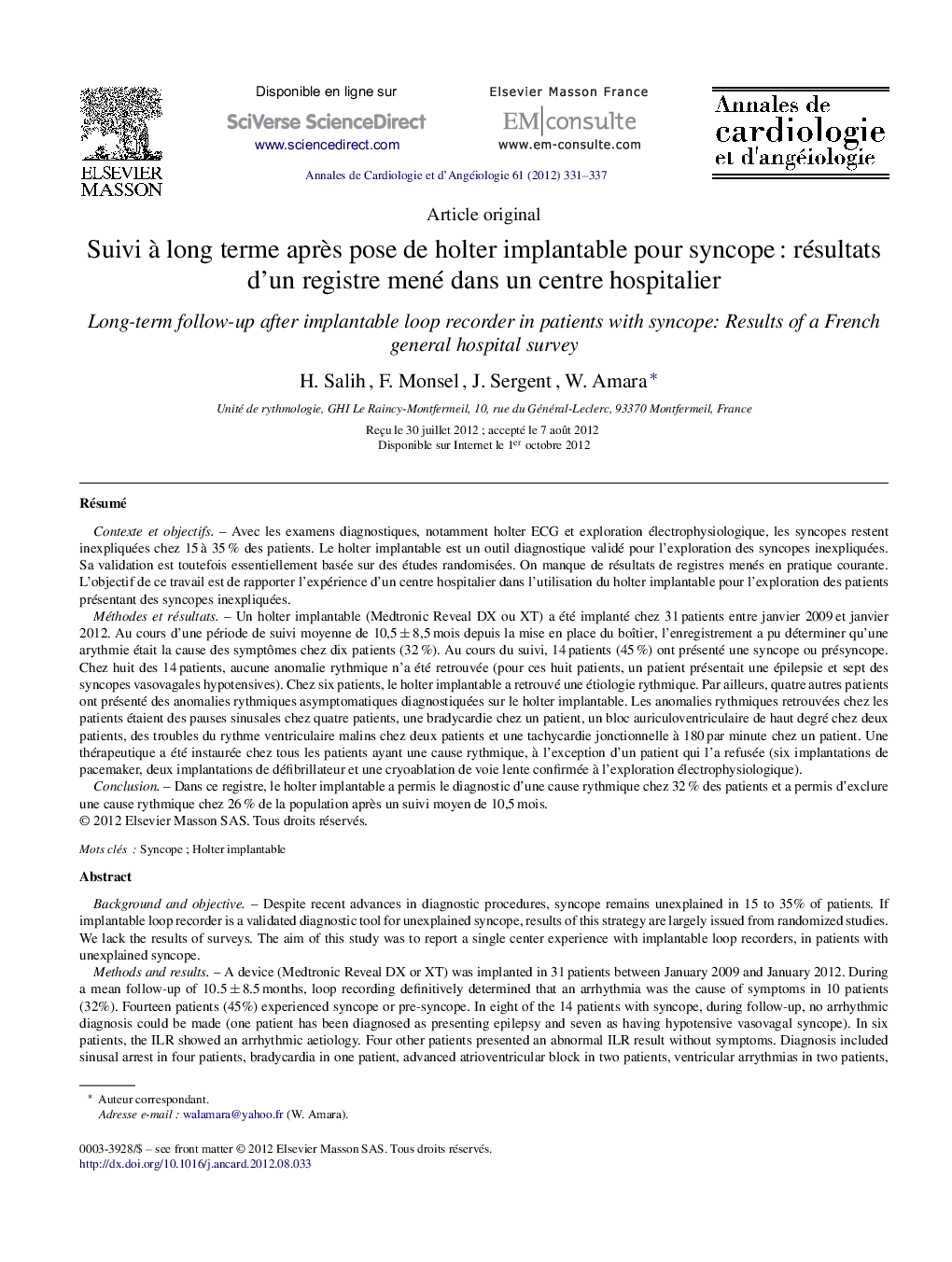| Article ID | Journal | Published Year | Pages | File Type |
|---|---|---|---|---|
| 2868868 | Annales de Cardiologie et d'Angéiologie | 2012 | 7 Pages |
RésuméContexte et objectifsAvec les examens diagnostiques, notamment holter ECG et exploration électrophysiologique, les syncopes restent inexpliquées chez 15 à 35 % des patients. Le holter implantable est un outil diagnostique validé pour l’exploration des syncopes inexpliquées. Sa validation est toutefois essentiellement basée sur des études randomisées. On manque de résultats de registres menés en pratique courante. L’objectif de ce travail est de rapporter l’expérience d’un centre hospitalier dans l’utilisation du holter implantable pour l’exploration des patients présentant des syncopes inexpliquées.Méthodes et résultatsUn holter implantable (Medtronic Reveal DX ou XT) a été implanté chez 31 patients entre janvier 2009 et janvier 2012. Au cours d’une période de suivi moyenne de 10,5 ± 8,5 mois depuis la mise en place du boîtier, l’enregistrement a pu déterminer qu’une arythmie était la cause des symptômes chez dix patients (32 %). Au cours du suivi, 14 patients (45 %) ont présenté une syncope ou présyncope. Chez huit des 14 patients, aucune anomalie rythmique n’a été retrouvée (pour ces huit patients, un patient présentait une épilepsie et sept des syncopes vasovagales hypotensives). Chez six patients, le holter implantable a retrouvé une étiologie rythmique. Par ailleurs, quatre autres patients ont présenté des anomalies rythmiques asymptomatiques diagnostiquées sur le holter implantable. Les anomalies rythmiques retrouvées chez les patients étaient des pauses sinusales chez quatre patients, une bradycardie chez un patient, un bloc auriculoventriculaire de haut degré chez deux patients, des troubles du rythme ventriculaire malins chez deux patients et une tachycardie jonctionnelle à 180 par minute chez un patient. Une thérapeutique a été instaurée chez tous les patients ayant une cause rythmique, à l’exception d’un patient qui l’a refusée (six implantations de pacemaker, deux implantations de défibrillateur et une cryoablation de voie lente confirmée à l’exploration électrophysiologique).ConclusionDans ce registre, le holter implantable a permis le diagnostic d’une cause rythmique chez 32 % des patients et a permis d’exclure une cause rythmique chez 26 % de la population après un suivi moyen de 10,5 mois.
Background and objectiveDespite recent advances in diagnostic procedures, syncope remains unexplained in 15 to 35% of patients. If implantable loop recorder is a validated diagnostic tool for unexplained syncope, results of this strategy are largely issued from randomized studies. We lack the results of surveys. The aim of this study was to report a single center experience with implantable loop recorders, in patients with unexplained syncope.Methods and resultsA device (Medtronic Reveal DX or XT) was implanted in 31 patients between January 2009 and January 2012. During a mean follow-up of 10.5 ± 8.5 months, loop recording definitively determined that an arrhythmia was the cause of symptoms in 10 patients (32%). Fourteen patients (45%) experienced syncope or pre-syncope. In eight of the 14 patients with syncope, during follow-up, no arrhythmic diagnosis could be made (one patient has been diagnosed as presenting epilepsy and seven as having hypotensive vasovagal syncope). In six patients, the ILR showed an arrhythmic aetiology. Four other patients presented an abnormal ILR result without symptoms. Diagnosis included sinusal arrest in four patients, bradycardia in one patient, advanced atrioventricular block in two patients, ventricular arrythmias in two patients, and supraventricular tachycardia of 180/min in one patient. Therapy was instituted in all patients, in whom an arrhythmic cause was found except one who refused the therapy (six pacemaker, two implantable cardioverter-defibrillator implantations, and one cryoablation of atrioventricular nodal reentrant tachycardia confirmed by an invasive exploration).ConclusionIn this survey, implantable loop recorder implantation led to the diagnosis of an arrhythmic cause in 32% of patients and excluded an arrhythmic cause in 26% of patient with a mean follow-up of 10.5 months.
